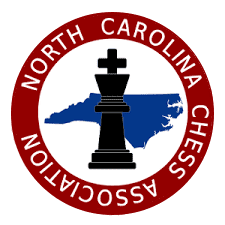
North Carolina Chess Association
NCCA officers
Charles Roberson – President
John Timmel – First Vice President
Grant Oen – Scholastic Vice President
Wayne H. Spon – Secretary/Treasurer
North Carolina Gambit – January 2023
In this issue, you will find:
Gordan Ray – Jim, The Man, The Myth, and the Legend
Patrick McCartney – My First Experience at the US Masters – Part I
Wayne Christensen and John Timmel – Games from the 2022 NC Senior Championship
John Timmel – To Move and Win!
We’re looking for contributors to the Gambit!
Submit your games, articles, etc. to the editor Charles Roberson at croberson2@triad.rr.com
Jim, The Man, The Myth, and the Legend – in memory of Jim Watson
by Gordan Ray
Last month Charles Robinson asked me to submit a poem in memory of Jim Watson and also to submit an article about him this month. As many of you know Jim was not only a physically imposing person, but in many ways, he was also a Larger than Life Figure. So it is my honor to try to tell you about “Jim, The Man, The Myth, and the Legend”.
I met Jim in 2009 at Via Cappuccino in Rocky Mount. He was a Big Guy with a Big Heart, and I quickly found out that people simply called him “Mr. Big Jim”. Over the last 13 years Big Jim was my chess mentor and friend. I learned many things from Jim about chess strategy, but I also learned how to think about the “Extra Things” that are associated with the game. Here are just a few:
- Study your opponent’s tendencies down to the details of how his body motions give away certain things.
- Know his Openings and know the purpose of your Openings.
- Know how well your opponent plays the Endgame.
- Practice Gambits because they will make you a better tactical player.
- Good position leads to good tactics.
- There is one thing that your opponent can never do. And, that is he can never affect how much you study chess.
- Review all of your games diligently with paper and pencil.
- Friends play chess, but there is no such thing as a friendly game of chess. He told me this after my first win against him. I will always cherish that moment.
- Learn to create an asymmetrical board and take advantage of it.
- If someone unintentionally distracts you, you must intentionally stop them.
- Remember Blumenfeld’s Rule. After you have made up your mind on a move, look at it one more time.
- He idealized General Patton. Patton simply believed everyone must fight, and so did Big Jim. He believed you should never hold anything in reserve but fight with every piece.
- Jim often said to me that we need to get chess into all the schools. It will make a difference in grades and in lives. I really did try. I guess I have taught over 500 students how to play.
- Arrive ahead of time to the tournament. Now he did preach this, but this is the one rule that he did not always follow. I still remember a harrowing experience of riding with Big Jim from Rocky Mount to Charlotte. I can’t describe it other than to just say that it was much scarier than any roller coaster ride you can imagine, and it was over 3 hours long. Once we got there all that I could think of was that I was going to have to ride back with him. It’s needless to say that I did not win many games that weekend.
- If you go to a chess tournament, and you decide to eat at Subway and the Turkey and Ham is on special, yet all you want is a Turkey Sandwich then order the Turkey and Ham without the Ham. It is cheaper that way. This is a true story.
Lastly, I want to share with you why Jim Watson played the Grob. Almost everyone that knew Jim knew that he played the Grob. Now you have to ask yourself why a Master would play such an offbeat opening. He told me that he was a Master by the time he was 27 years old and that he and his wife were beginning to raise their family. He said that his love for family was much more important than his love for chess, so he decided he did not have enough time to memorize traditional openings and games out to 20 plus moves. He had already done that for years. So, he decided he would create an asymmetrical board by playing the Grob, and he thought he could then simply “out-chess” most people because everyone would be out of book.
I decided to play the Grob in his memory in Henderson shortly after his passing. I played white twice and got a win and a draw. Both games yielded “Jim-like” positions where I was able to use another one of Jim’s ideas called Quadrant Theory. I actually won the tournament with 2.5 points out of 3. Also, Henry Hopson recently got a win, in a Wilson Tournament, where he played the Grob in Jim’s memory. He even told me that he convinced Benjamin Snodgrass to play it once. Ben got a crushing win with it as well. So maybe Jim was onto something there. Create an asymmetrical board and “out-chess” your opponent. RIP Big Jim. You were one of a kind.
Submitted by Gordan Ray 11/14/2022
My First Experience at the US Masters – Part I
by Patrick McCartney
The US Masters is a restricted tournament
where either your USCF or FIDE rating must either be 2200 or over or once was 2200 or over. My USCF rating was never higher than 2185,
but because only select events in the United States are FIDE rated, and because I happened to have excellent results in my first couple of FIDE-rated events, such as the 2002 US Open, I happened to be over 2200 from 2004 to 2006, and therefore I decided to give the US Masters a stab. It was definitely a different experience than playing the A-players and experts that I face all the time at the club. Even when you think you have a game won or drawn, think again! I thought I had a drawn ending in the second round just to have my pawns become shattered and another loss occurs. In fact, I lost the first three games before my results basically took a complete 180. After losing the first three games, I won the fourth round, which is the game I will be analyzing here. That was followed by two draws in rounds five and six before winning my seventh round, which will be the game analyzed in Part II next month. However, an observation that I made during this tournament is that there was a lot of coughing going on in the room. My first-round opponent was coughing, along with a few others in the first round on Wednesday night.
Things got a little worse on Thursday, and then even worse than that on Friday, and Friday night, I start coughing. Saturday was even worse than Friday throughout the room, and on Saturday night, I come down with flu symptoms and was unable to play the final two rounds on Sunday. So in a tournament where I started out as the 186th seed out of 202 players, I figured I’d be fortunate to score 2 1/2 or 3 points out of a possible 9. I wind up scoring 3 points out of only 7 rounds and will gain about 25 to 30 points on my FIDE rating as a result of it. This fourth-round game that will be analyzed here will see White playing an offbeat flank opening, Sokolsky’s Opening (a.k.a. The Polish Attack
or The Orangutan), but after getting Black’s e-pawn for his b-pawn, White relinquishes his dark-squared bishop for a knight, and takes over the central dark squares by placing all of his pawns on dark squares. Then it becomes a matter of finding the right time to break in the center with the move e4, and after a few tactics, White winds up with a dangerous passed pawn that White uses to transition to a winning king and pawn endgame. Without further ado, let’s take a look at the game.
White – Patrick McCartney
Black – Roger Zhang
1. b4 e5 2. Bb2 Bxb4 3. Bxe5 Nf6 4. c3
This is a more modern interpretation of the opening than the older, and
probably more common, 4.c4 or 4.Nf3
White’s idea is simple. Trade the bishop
for the knight on f6 and park the pawns on the dark squares, blunting Black’s
unopposed bishop.
Be7 5. g3
There is no need to take the knight yet as
moving the knight would either drop the g-pawn, or else Black would have to
place the knight on h5, which with the move g3 played by White, is not a
productive move for Black. There is an alternative here, 5.e3, which was
played by Carlsen himself against Nakamura in 2021. Black has a number of
options here, like 5…c5 (what Nakamura played), 5…O-O, 5…Nc6, or 5…d5.
After something like 5…d5, White can play 6.Bxf6 Bxf6 7.d4 O-O 8.Bd3 c5 9.Ne2 g6 10.O-O Nc6
the position is roughly equal. The Sokolsky does not typically lead to an
advantage for White, but a playable position with rough equality can
easily be achieved, and the game is often decided in the middlegame or endgame.
5….Nc6
This puts the immediate question on the bishop.
That said, even after a move like 5…d5 or 5…O-O, White’s response would be
the same. After 5…O-O, Black threatens to play 6…Ng4 as g7 is protected,
and the Bishop has nowhere good to go. After 5…d5, White needs to also take
the knight immediately so as to force Black to recapture with the bishop,
which is White’s intent all along, following up with plugging up the dark
squares with pawns. Delaying the capture would allow 6…Nbd7, and recapturing
on f6 with the knight, which would benefit Black.
6. Bxf6 Bxf6 7. e3
Before fianchettoing the bishop, White sets up the d4-push, which he will play either
the moment that Black plays …d5, or if Black doesn’t ever push the d-pawn
that far, then at some point when White has nothing more convenient to play.
O-O 8. Bg2 d5 9. d4 Na5 10. Nd2
White delays the development of the King’s
knight so as to not allow 10…Bg4 by Black, and this also contests control of
the c4-square. If Black goes to c4, White can trade and have Black’s pawns be
less than ideal.
10….Bf5
I don’t like this move for Black at all as it allows White to develop the queen with tempo.
11. Qf3 Be6
If 11…Qd7, the d-pawn hangs.
12. Ne2 Qd7 13. Nf4 c6
This move does threaten to trap the White
queen with a subsequent …Bg4, but it would be better to develop his last
piece via 13…Rad8. The game move just forces White to play a move he
probably wants to play anyway as it leads to a favorable trade, gaining near
complete control of the light squares.
14. Nxe6 fxe6 15. Qg4
Pinning the weak e6-pawn to the queen.
c5 16. O-O Rac8 17. Bh3 Rfe8 18. Rfc1 Rc6?!
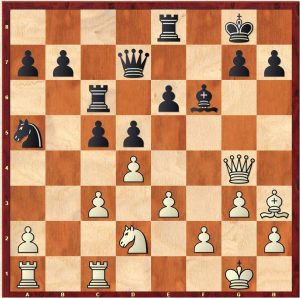
I don’t like this move for Black as it gives White tactical reasons to break
at this point in the center.
19. e4! cxd4 20. exd5
And the fact that the pawn now attacks the rook makes the in-between move
…dxc3 impossible for Black.
No matter what Black does here, White is better. He cannot recapture on d5
with the pawn. Recapturing via 20…Qxd5 allows 21.Ne4 or 21.Bg2, both of
which are better for White, and the game move isn’t any better. This is why I
don’t like Black’s 18th move.
Rxc3 21. Ne4
With the major threat of 22.Nxf6+, winning the queen, combined
with the e6-pawn still being a dead duck.
Rxc1+ 22. Rxc1 Qd8
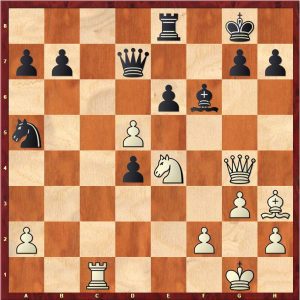
23. Rc8
23.Qh5 may be even stronger, but White’s idea here is
with a dangerous pawn on e6, White deflects the queen from guarding the bishop
on f6, and forces the exchange of two more pieces each.} Qxc8 24. Nxf6+ Kh8 25.
Nxe8 Qxe8 26. dxe6 {Only now does White take the pawn. The e6-pawn is more
dangerous than the d4-pawn.} Nc6 27. Qe4 Kg8 28. Bf1 {White re-routes the
bishop to the d5-square, a better square to guard the e6-pawn from than h3.
Black has nothing here, and so White has the time to rearrange his pieces.
g6 29. Bc4 a6 30. Bd5 Qe7
This drops a pawn, but what else is Black going to do?
He can keep the material with a move like 30…h5 31.h4 Kh7, but it also
creates even more weaknesses for Black, and he would be very close to running
out of moves.
31. Bxc6 bxc6 32. Qxc6 d3
White is completely winning, and while computers might prefer 33.Qxa6 here,
I decided to take the simpler route to victory.
33. Qd7
The important factors to keep in mind here are that Black cannot trade queens
as White’s d-pawn would promote before Black’s, and that the Queen cannot move away.
Kf8
This move is virtually forced as Black cannot move the queen due to Qf7+ and e7, winning easily.
34. Kf1
This forces a winning pawn ending. White’s idea is simple. If Black trades queens,
both the passed pawns drop and White wins the 4-on-3 pawn ending. If Black
doesn’t trade queens, White will force the issue.
Qf6 35. e7+ Qxe7 36. Qxe7+ Kxe7 37. Ke1 Ke6 38. Kd2 Kf5
One last attempt at a trick.
39. f3
White doesn’t allow it and delays the capture of the d-pawn by a move. After 39.Kxd3,
Black has 39…Kg4.
Ke5 40. Kxd3 1-0
Black resigned, realizing that the position is completely lost.
This tournament was definitely a learning experience.
While I don’t advocate playing up in every tournament you play, every once in
a while, playing against stronger opposition can be a definite learning
experience. Next month, I’ll analyze my Round 7 victory. Until then, this is a
great time to play in tournaments. Who wants to be outside in the brutal cold anyway?
Games from the 2022 North Carolina Senior Championship
games from Wayne Christensen, notes by Wayne
Shedor, Peter (1516) – Christensen, Wayne (2078) Round 1
1.d4 Nf6 2.Nf3 e6 3.e3 c5 4.c3 Be7 5.Bd3 Nc6 6.Nbd2 0-0 7.0-0 b6 8.Qe2 Bb7 9.e4 I thought this was premature. 9.a3 would prep the move so the Black N would be denied the b4 square. 9…cxd4 10.e5 !? [10.Nxd4 Ne5 11.Bc2 Is safer.; 10.cxd4 Nb4] 10…Nd5 11.Qe4 f5 12.exf6 Nxf6 13.Qh4 dxc3 14.bxc3 [14.Ne4 Nd5 15.Qh3 Ncb4 The d5 N has to stay to cover f6 in case of any discovered checks..] 14…Qe8 15.Ng5 h6 16.Nde4 Ne5 17.Nxf6+ [17.Bc2 Rc8] 17…Bxf6 18.Bh7+ Kh8 19.Bc2 Rc8 20.f4 [20.Bb3 Rxc3] 20…Rc4 21.Qh3 Bxg5 22.fxg5 Rxf1+ 23.Kxf1 Rg4 24.g3 Qf8+ 25.Bf4 Rxf4+ 26.gxf4 Qxf4+ 27.Ke1 [27.Ke2 Bf3+ 28.Ke1 Nc4] 27…Nf3+ 28.Kd1 [28.Ke2 Qd2+ 29.Kf1 Ba6+] 28…Qd2# 0-1
Christensen, Wayne (2078) – Goodwin, Brian (1476) Round 5
1.d4 Nf6 2.c4 e6 3.g3 d5 4.Nf3 Be7 5.Bg2 0-0 6.0-0 dxc4 7.a4 ?! I had a senior moment, and forgot to play 7 Qc2 first. [7.Qc2 a6 8.a4 c5 9.dxc5 Bxc5 10.Nbd2] 7…c5 [7…Nc6] 8.dxc5 Qxd1 [8…Bxc5 9.Qc2 Nc6 10.Qxc4] 9.Rxd1 Bxc5 10.Ne5 [10.Na3 Ne4 11.Rf1 I would prefer to capture on c4 with the QN, but this line is wrong headed.] 10…Nfd7 It’s hard to suggest something for Black. The computer likes 10…,Nc6, but I would never consider that. 11.Nxc4 Nc6 12.Nc3 Nd4 ‘better is’ …e5, to free the B/0 13.Bf4 a6 14.Bd6 Bxd6 15.Nxd6 Nc6 ? [15…Nb3 16.Ra3 Ndc5 17.Nce4 Nxe4 18.Bxe4 Nc5 19.Bf3 e5 20.b4 Ne6 this is as far as I could see. The computer shows White winning a P from here.] 16.Nxc8 1-0
Garcia, Baldomera (2012) – Wayne, Christensen (2078) Round 2
1.e4 e5 2.Bc4 Nf6 3.d3 Nc6 Every book I have advocates 3…,c6 as easy equality. But I can’t help feeling every Bishop’s Opening player likes the White side, so I play something diferent. [3…c6 4.Nf3 d5 5.Bb3 (5.exd5 cxd5 6.Bb5+ Bd7 7.Bxd7+ Nbxd7 8.0-0 Bd6) 5…a5 6.a4 Bb4+ 7.c3 Bd6] 4.Nc3 Be7 [4…Na5 5.Nge2 Nxc4 6.dxc4 d6 7.Bg5 Be7 8.Qd3 0-0 9.h3] 5.f4 d6 6.Nf3 Bg4 7.h3 Bxf3 8.Qxf3 Nd4 9.Qd1 [9.Qf2 0-0 10.Be3 c5 Dominique Myers-Christensen 2014] 9…c6 10.0-0 !? I don’t get this move. White’s P structure is damaged [10.a3 exf4 11.Bxf4 d5 12.exd5 cxd5 13.Ba2 Qb6] 10…b5 11.Bb3 a5 12.a3 Nxb3 13.cxb3 0-0 14.Qf3 Nd7 15.Be3 Nc5 16.Rad1 [16.Bxc5 dxc5 And Black is planning …Qd4+ & …,c4 17.f5 Bf6] 16…Nxb3 17.Ne2 Bf6 18.d4 Nxd4 19.Nxd4 exd4 20.Bxd4 Bxd4+ 21.Rxd4 Qe7 [21…Qb6 22.Rfd1 f5] 22.Rfd1 Rad8 23.Qd3 Rfe8 24.e5 This is as far as I could see when I took the pawn. And from afar 24…,d5 looked obvious. 24…d5 ?! A thoughtless move that throws away the advantage. I overlooked White’s threat of 25Qc3 with a double attack on the c & a Ps. [24…Qa7 ! 25.Kh2 (25.Kh1 d5) 25…d5 26.Rc1 Re6] 25.Qc3 Qa7 ?! [‘better is’ 25…Qb7 26.Qxa5 c5 27.R4d3 d4 28.Rb3 (28.b4 I thought b4 broke up Black’s Ps, not seeing …,Ra8 winning the White Q.) 28…Rb8 29.a4 Qe4 And Black is still fighting.; 25…Rc8 26.Qxa5 f6 27.exf6 Qxf6 28.Qc3] 26.Qxc6 b4 I lost the thread of the game here, when I found a big hole in my tactics. [26…Rc8 27.Qxb5 (27.Qxd5 Red8 I thought this won a R, but the computer found a save. 28.Qb7 !) 27…Rc4 28.Qxd5 I missed this in my initial analysis, and now thought I was completely lost.] 27.Kh2 bxa3 28.bxa3 h5 Something that I have changed in my game is a willingness to create luft with …h5, instead of …,h6. In this case, however, I had a point in mind of a possible …, h4, as I was already planning …,g5 if I had the chance. 29.R1d3 ?! Letting me back into the game. [‘better is’ 29.Rxd5] 29…Re6 30.Qb5 g5 Desparate attempt for perpetual check. 31.fxg5 Rxe5 32.Rxd5 Rexd5 [32…Rdxd5 33.Rxd5 Rxd5 34.Qxd5 Qc7+ 35.Kg1 Qc1+ 36.Kf2 Qb2+] 33.Rxd5 Qc7+ 34.Kg1 [34.g3 Qc2+ 35.Kg1 Rc8 36.Re5 Qc1+ Is perpetual.; 34.Re5 The best winning try. 34…a4] 34…Qc1+ 35.Kh2 Qf4+ 36.Kg1 Qc1+ 37.Kh2 Qf4+ 1/2-1/2 1/2-1/2
Hasman, Dr. Henry Jhon (1900) – Christensen, Wayne (2078) Round 3
1.d4 Nf6 2.c4 e6 3.Nc3 Bb4 4.f3 c5 5.a3 Ba5 [5…Bxc3+ 6.bxc3 Nc6 7.e4 d6 This was as much book as I could remember, and I had no idea how to continue, so I tried to get my opponent out of his book.] 6.e3 0-0 [6…d5] 7.Bd3 Bxc3+ [‘better is’ 7…d5 This move is more thematic after f3 by ‘White. 8.Nge2 dxc4 9.Bxc4 cxd4 10.exd4 Nc6 I was sure I was equal here, but I was not sure if I could win it, so I switched back to a Saemisch structure.] 8.bxc3 Nc6 9.Ne2 b6 10.0-0 Ba6 11.Nf4 Rc8 ?! Wasting a valuable tempo. [‘better is’ 11…Na5 12.Qe2 d6 I doubt I would have played this move anyway. My mind was made up the remaneuver the King’s N to d6. 13.Bd2 (13.e4 cxd4 14.cxd4 Rc8) 13…Rc8 14.d5 Qe8 a computer move ‘with the idea’ …,Qa4 and pressing the cP.] 12.d5 Na5 13.Qe2 Ne8 [‘better is’ 13…e5 Driving the White N to h3. 14.Nh3 Ne8 15.e4 Nd6 16.f4 f6 17.fxe5 fxe5 18.Bg5 Rxf1+ 19.Rxf1 Qe8 20.Rf3 Bxc4 21.Rg3 Bxd3 22.Qxd3 A computer line. I don’t remember looking at it this deeply. But it looks like White still has excellent attacking chances here.; 13…Nb3 14.Rb1 Nxc1 15.Rfxc1 Qc7 After White plays d5, it’s harder to win the cP, so I Iooked at this line, but Black’s position looks like it’s hard to play for a win, and I still wanted to win.] 14.e4 e5 15.Nh5 Nd6 ?! My K safety switch was in the off position. I had no idea how much trouble I was in. I played this move on intuition, without concrete analysis, as I did not like 15…,Qh4. [‘better is’ 15…Qh4 16.f4 (16.Ng3 Nd6) 16…g6 (16…Nb3 17.fxe5 Nxa1 I saw this much, but I had no idea how to defend it.) 17.fxe5 (17.Ng3 Nb3 18.fxe5 Nxa1 It looks like Black can get away with grabbing the R.) 17…Qxh5 18.Qxh5 gxh5 19.Bh6 I saw this much, and did not like the 2Ns against White’s R. Though the computer likes Black. 19…Bxc4 20.Bxc4 Nxc4 21.Rf5] 16.f4 f6 17.Qg4 Reality set in here. I knew I was lost, and started losing the thread of the game. 17…Qe7 18.fxe5 fxe5 19.Bg5 Qe8 20.Rxf8+ Qxf8 21.Rf1 Qe8 22.Bd8 [22.Nf6+ gxf6 23.Rxf6 is the line I was expecting where it is mate or I lose my Q, so I perked up a little, but in a bad position, all moves are bad! (Tarrash).] 22…Qg6 23.Qxd7 Bxc4 24.Bxc4 Naxc4 25.Qe7 Rxd8 26.Qxd8+ Ne8 [26…Qe8 27.Qg5 Qg6 (27…Qd7 28.Nf6+) 28.Qe7 h6 29.Rf8+ Kh7 30.Nf6+] 27.Qe7 [h6 27.Rf8+ Kh7 Qxe8] 1-0
Dr. Hasman conducted a strong attack in a fine game. My congratulations to him for winning the tournament.
Christensen, Wayne (2078) – Ray, Gordon (1560) Round 4
1.d4 Nf6 2.c4 c5 3.d5 b5 4.cxb5 a6 5.Nf3 g6 6.Qc2 Yermolinsky’s suggestion to threaten Black’s cP, and play e4 in one move. 6…d6 7.e4 Bg7 8.Nc3 0-0 9.a4 Ng4 10.Be2 Ne5 11.Nxe5 Bxe5 12.0-0 Nd7 13.Be3 ?! Planning f4,f5 and an attack, but I thought it out poorly. 13…Bg7 14.Rab1 Qa5 15.Bd2 Qc7 16.Rfc1 Bd4 Allowing a N fork. [16…axb5 17.Bxb5 f5; 16…Bb7 17.b3 This would approximate Carlsen’s plan of White playing on the Qside light squares, leaving Black’s dark squared B unemployed.] 17.bxa6 Bxa6 18.Bxa6 Rxa6 19.Nb5 Qb6 20.Nxd4 cxd4 21.b4 Raa8 22.Qc7 Ra7 23.Qxb6 Nxb6 24.a5 Na4 [24…Nd7 25.b5 Nc5 26.f3] 25.Kf1 Rb8 26.Ke2 Nc3+ 27.Bxc3 dxc3 28.Kd3 Rb5 29.Kxc3 Rc7+ [29…Rab7 30.a6 Ra7 31.Kc4 Rb6 32.b5] 30.Kb3 Rcb7 31.Ka4 Rb8 32.a6 1-0
games from John Timmel, notes by John
Timmel, John (2032) – Cato, Tony (1500) Round 1
1.e4 d5 2.exd5 Qxd5 3.d4 e5 4.dxe5 Qxe5+ 5.Be2 Be6 6.Nf3 Qd6 7.Nd4 Nc6 8.Nxc6 Qxd1+ 9.Bxd1 bxc6 10.Nc3 Bb4 11.Bd2 Nf6 12.a3 Be7 13.Be2 Nd5 14.Bf3 Bf6 15.Na4 0-0-0 16.0-0-0 Be7 17.Be4 Kb7 18.Rhe1 Nb6 19.Nxb6 cxb6 20.f4 Bf6 21.h3 Bd5 22.g4 Bh4 23.Re3 Bxe4 24.Rxe4 Rhe8 25.Rxe8 Rxe8 26.Bc3 Rd8 27.Bxg7 Rxd1+ 28.Kxd1 Kc7 29.Be5+ Kd7 30.f5 c5 31.Ke2 Kc6 32.c4 b5 33.Kd3 b4 34.a4 a5 35.Ke4 f6 36.Bf4 b3 37.Kd3 Be1 38.Bd2 Bxd2 39.Kxd2 Kd6 40.Ke2 Ke5
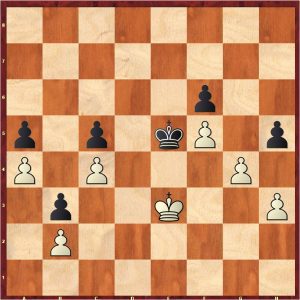
41.Ke3 h5 42.Kf3 h4 43.Ke3 Kd6 44.Kf4 Ke7 45.g5 fxg5+ 46.Kxg5 Kf7 47.Kxh4 Kf6 48.Kg4 Kf7 49.Kg5 Kg7 50.f6+ Kf7 51.Kf5 Kf8 52.Ke6 Ke8 53.f7+ Kf8 54.h4 Kg7 55.Ke7 1-0
Timmel,John (2032) – Spon, Wayne (1500) Round 3
1.d4 e6 2.Bf4 Nf6 3.e3 b6 4.Bd3 Bb7 5.f3 Nd5 6.Qd2 Nxf4 7.exf4 Qf6 8.Ne2 c5 9.Nbc3 d5 10.dxc5 Bxc5 11.0-0-0 0-0 12.g4 Qe7 13.Rde1 Bc6 14.Ng3 Qd8 15.Nd1 Bd7 16.f5 Nc6 17.Nh5 Be7 18.Qg2 Bh4 19.Reg1 h6 20.f4 exf5 21.gxf5 Bf6
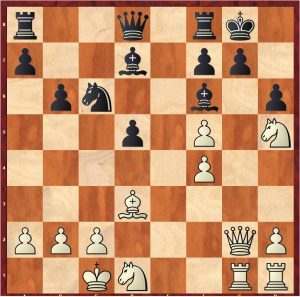
22.Qxd5 Nb4? 23.Qxd7 Nxd3+ 24.Qxd3 Qxd3 25.Nxf6+ Kh8 26.cxd3 gxf6 27.Rg3 Rg8 28.Rhg1 Rxg3 29.Rxg3 Rc8+ 30.Kd2 Rc5 31.Ne3 Kh7 32.d4 1-0
Hasman, Dr. Henry Jhon (1900) – Timmel, John (2032) Round 4
1.Nf3 Nf6 2.c4 g6 3.b3 c6 4.Bb2 Bg7 5.g3 0-0 6.Bg2 d5 7.0-0 Na6 8.d3 Bg4 9.Nbd2 Qc8 10.Rc1 dxc4 11.Rxc4 Bh3 12.Qa1 Nc7 13.Rfc1 Bxg2 14.Kxg2 Nfe8 15.Bxg7 Nxg7 16.Nf1 Nd5 17.a4 Qe6 18.Qb2 f6 19.a5 a6 20.b4 Ne8 21.Qd2 Nd6 22.Rc5 Rad8 23.h3 Nc7 24.Qb2 Ndb5 25.Ne3 Qd6 26.Nc4 Qd7 27.Nb6 Qd6 28.Na4 e5 29.R5c4 Ne6 30.h4 Rf7 31.h5 Ned4 32.hxg6 hxg6 33.Rh1 Nxf3 34.exf3 Nd4 35.Qc1 Qd5 (g5 or Rh7 is required)
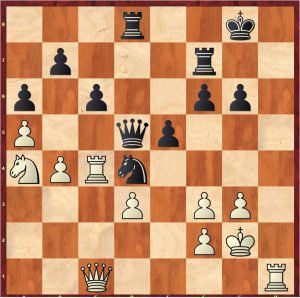
36.Rxd4! (forced, but good!) Qxd4 37.Qh6 Rg7 38.Nc5 (the white knight has black reeling) Re8 39.Rh4 Qd5 40.Nxb7 Qxd3 41.Nc5 Qd5 42.Qe3 g5 43.Rh6 Kf7?
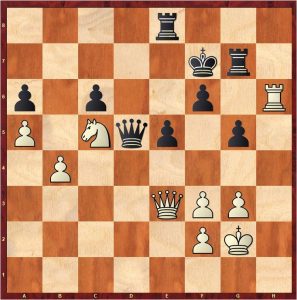
44.Nxa6? (missing the kill 44. Ne4!) g4 45.Nc5 Qxf3+ (missing gxf3+ 46. Qxf3 Rxg3+! followed by Qd2+ picking off the rook) 46.Qxf3 gxf3+ 47.Kxf3 Ke7 48.Ne4 Rb8 49.Ke3 Rxb4 50.Nxf6 Ra4 51.Nh5 Rgg4 52.Rxc6 Ra3+ 53.Ke2 Rxa5 54.Nf6 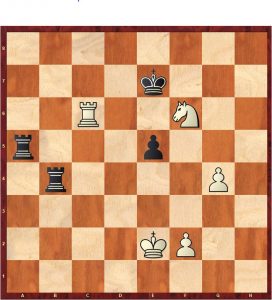
Rb4? (black has turned the tables, but accuracy is needed. Ra2+ driving the white K to the back rank is best) 55.g4 Rf4 56.g5! Ra2+ 57.Ke3 Rfxf2 58.Ke4 Rae2+ 59.Kd5 Kf7 60.Ne4 Rg2 61.Rc7+ Kg6 62.Rc6+ Kg7 1/2-1/2
To Move and Win! – John Timmel
games from the 2022 NC Senior Championship
2022 NC Senior Championship
Shedor – Timmel round 2
Black to move and win
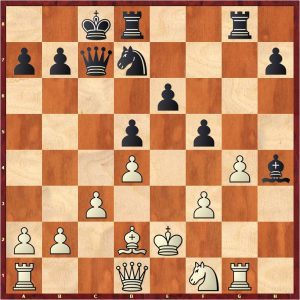
Qc4+ 20.Ke3 f4+ 21.Kxf4 e5+
22.Ke3 exd4+ 23.cxd4 Rde8+ 0-1
2022 NC Senior Championship
Timmel – Garcia round 5
Black to move
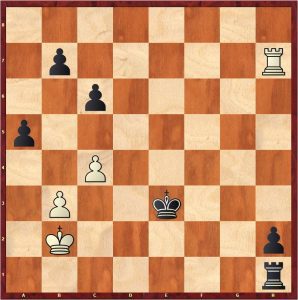
62…Re1!
63.Rxh2 Re2+ 64.Rxe2+ Kxe2 65.Kc2 b6 66.Kc3 Ke3
67.Kb2 Kd2 68.Ka3 Kc3 69.Ka4 Kd4 70.Ka3 b5 71.cxb5 cxb5 0-1
2022 NC Senior Championship
Hasman – Christensen Round 3
after 15….Nd6, White to move
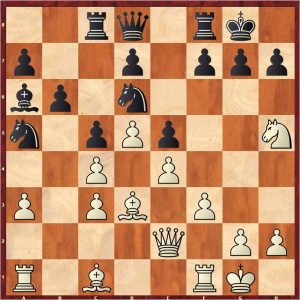
16.f4! and black is helpless
The game finished (with Wayne’s notes)
f6 17.Qg4 Reality set in here. I knew I was lost, and started losing the thread of the game. 17…Qe7 18.fxe5 fxe5 19.Bg5 Qe8 20.Rxf8+ Qxf8 21.Rf1 Qe8 22.Bd8 [22.Nf6+ gxf6 23.Rxf6 is the line I was expecting where it is mate or I lose my Q, so I perked up a little, but in a bad position, all moves are bad! (Tarrash).] 22…Qg6 23.Qxd7 Bxc4 24.Bxc4 Naxc4 25.Qe7
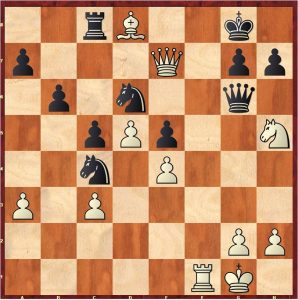
Rxd8 26.Qxd8+ Ne8
[26…Qe8 27.Qg5 Qg6 (27…Qd7 28.Nf6+) 28.Qe7 h6 29.Rf8+ Kh7 30.Nf6+] 27.Qe7 1-0